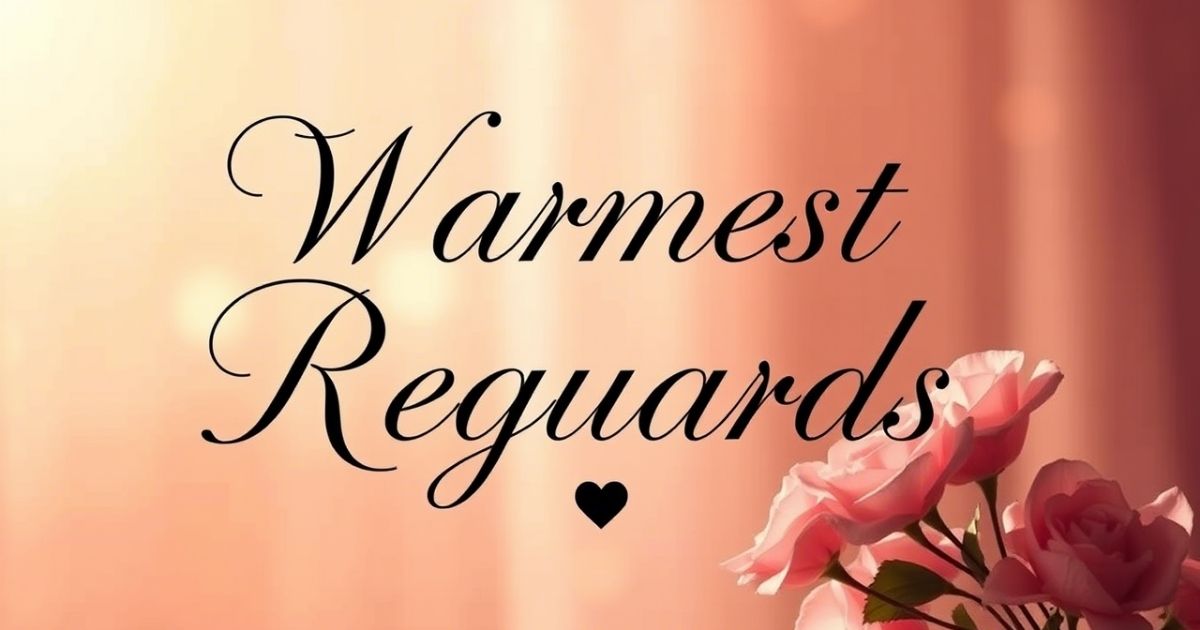Warmest Regards is a common and friendly sign off in emails and letters. It’s used to express kindness and respect while maintaining professionalism. People often choose Regards when they want to end a message on a positive, sincere note. If you’re looking for Warmest Regards synonyms,” there are a few great alternatives. For instance, “Warm Regards” is a simple, friendly option that keeps the tone warm.
Warmest Regards is another synonym that conveys politeness and warmth. You might also use “Sincerely” or “Best Regards” as another way to say “warm regards.Warmest Regards If you want something a little more casual,another way to say warm regards or “Affectionately” could work well. Each of these variations offers a personal touch while still maintaining professionalism. Choosing the right sign-off can help ensure your communication feels genuine and thoughtful.
Main Points
- Friendly sign-offs help set the right tone in emails.
- Common alternatives include “Kind Regards” and “Best Wishes.”
- The right closing can strengthen your message and relationship.
- Consider the level of formality and closeness with the recipient.
- Personalize your email closure to leave a positive impression.
Best Wishes
Best Wishes is a warm and friendly phrase often used to express hope for someone’s future success or happiness. It is commonly seen in cards, emails, and even informal messages. People use it to send positive energy and support.
This phrase is versatile and can be used in both personal and professional settings. It conveys sincerity, whether you’re wishing someone good luck in their career or hoping for their well-being.
“Best Wishes” is universally understood.
Using “Best Wishes” helps to build a connection. It shows that you care about the person’s journey. Whether it’s for a birthday, a new job, or a life event, it leaves a lasting impression.
With Appreciation
“With Appreciation” is a phrase that conveys gratitude. It’s perfect for expressing thanks in a polite and formal way. It’s commonly used in professional emails or letters. It shows that you value someone’s effort or kindness.
When you want to acknowledge someone’s help, “With Appreciation” works well. It’s often used after completing a project or receiving assistance. This phrase leaves a positive mark and strengthens relationships.
Using “With Appreciation” shows respect. It emphasizes gratitude and sincerity in communication. It’s a respectful way to show acknowledgment without being too casual or overly formal. It fits many different contexts in professional and personal situations.
Regards

“Regards” is a polite and neutral way to close an email or letter. It’s widely used in both professional and personal settings. “Regards” can be followed by variations like “Kind Regards” or “Best Regards” for extra warmth.
When you use “Regards,” you’re sending a polite, respectful message. It shows that you appreciate the reader’s time and attention. It’s not too formal but still maintains a level of professionalism.
It’s a simple sign off that’s perfect for most situations. Whether you’re replying to a colleague or writing a formal business letter, “Regards” is a safe choice. It’s versatile and can adapt to different tones and contexts.
All the Best
“All the Best” is a warm and encouraging phrase often used to wish someone success or good luck. People use it in both personal and professional communication. It shows positivity and genuine care for the recipient’s future.
When you say “All the Best,” you are expressing your best wishes in a simple yet heartfelt way. It’s perfect for both formal and informal situations. It’s a thoughtful phrase to close emails, letters, and messages.
This phrase is commonly used for milestones or events like exams, job changes, or personal endeavors. It’s a quick way to show support and encouragement. It leaves a positive impression and shows that you truly care.
Kind Regards
“Kind Regards” is a friendly and polite way to end an email or letter. It expresses warmth and respect in both personal and professional communication. This phrase is used to maintain a balance between friendliness and formality.
“Kind Regards” is a commonly used sign-off, especially in business communication. It is more casual than “Sincerely,” but still maintains professionalism. It’s suitable for a wide range of interactions.
Using “Kind Regards” helps to keep the tone of the message respectful without being overly formal. It’s a versatile phrase that fits many different types of correspondence. Whether it’s a colleague or a friend, it’s always appreciated.
Sincerely
“Sincerely” is a formal and respectful sign-off commonly used in professional correspondence. It conveys honesty and sincerity. When you end a letter or email with “Sincerely,” you are showing that your message is genuine.
This phrase is often used in business settings, job applications, and formal letters. It’s perfect when you need to convey a sense of professionalism and trustworthiness. “Sincerely” is one of the most formal sign-offs.
While “Sincerely” is highly formal, it’s still widely used due to its clarity and professionalism. It’s appropriate for situations where respect and formality are important. It’s a timeless way to close letters and emails.
Related Guide:
10 Other Ways to Say “Have a Great Weekend”
Yours Truly
“Yours Truly” is a formal and respectful sign-off often used in business and personal letters. It conveys sincerity and honesty. When you use “Yours Truly,” you’re showing that your words come from the heart.
This phrase is typically used at the end of formal correspondence, such as job applications or official letters. It is seen as polite and professional. “Yours Truly” maintains a respectful distance while still being personable.
While it may seem old-fashioned, “Yours Truly” still has a timeless appeal. It’s often seen as more formal than other sign-offs like “Best Regards.” It’s a safe choice when professionalism is key to your communication.
Best Regards
“Best Regards” is a common, friendly sign-off used to close emails or letters. It’s warm yet professional, making it a versatile choice for both personal and business communication. “Best Regards” shows respect while maintaining a positive tone.
This phrase works well in emails to colleagues, clients, or friends. It’s appropriate when you want to send your best wishes without being overly formal. It strikes a nice balance between warmth and professionalism.
“Best Regards” is widely used because it’s polite and flexible. Whether you’re writing a casual note or a business email, it’s an ideal way to end your message with kindness.
Warm Regards

“Warm Regards” is a friendly sign-off that conveys a genuine sense of warmth and respect. It’s often used in both professional and personal emails to create a sense of closeness while maintaining politeness.
This phrase works well when you want to express warmth without being too casual. It’s perfect for messages to colleagues, clients, or acquaintances with whom you have a positive relationship.
Using “Warm Regards” helps create a personal connection. It shows that you value the recipient and care about the relationship. It’s a thoughtful and respectful way to close a message.
Sending Good Vibes
“Sending Good Vibes” is a casual and uplifting way to end a message. It expresses positivity and well-wishing. When you use this phrase, you are sending a burst of good energy to someone, wishing them all the best.
This sign-off is often used in informal emails or messages to friends and family. It’s a way to show that you care about the person’s well-being and want them to feel positive. It’s a feel-good sign-off that lifts spirits.
“Sending Good Vibes” works well when you want to brighten someone’s day. It’s an energetic and friendly way to express support. It’s perfect for messages that are lighthearted but still thoughtful.
Affectionately
“Affectionately” is a warm and loving way to sign off. It conveys a deep sense of care and personal connection. When you use “Affectionately,” you’re showing genuine affection for the recipient, making it a more intimate closing.
This phrase is often used in personal messages to close a letter or email with love. It’s perfect for communicating warmth and closeness to friends, family, or loved ones. “Affectionately” gives a heartfelt touch to your communication.
“Affectionately” might be less common in professional settings, but it’s perfect for more personal messages. It’s ideal when you want to convey warmth and love without being overly casual. It’s a sweet and sincere way to close.
Take Care
“Take Care” is a friendly and caring sign-off that shows concern for the recipient’s well-being. It’s commonly used in both personal and professional settings. This phrase lets someone know that you’re thinking of them.
It’s simple, yet meaningful, expressing that you hope the person stays safe and happy. “Take Care” is often used when ending a conversation or email with someone you know well. It’s a kind way to say goodbye.
Using “Take Care” creates a positive and thoughtful vibe. It’s a versatile sign-off that fits a wide range of situations. Whether it’s a friend or a colleague, it’s a sign-off that shows you care.
Yours Sincerely

“Yours Sincerely” is a formal and respectful sign-off often used in business and professional communication. It conveys professionalism and trustworthiness. It’s typically used when you don’t know the recipient well but want to keep things polite.
This phrase is often seen in formal emails, letters, and job applications. It’s appropriate when you want to show that your message is serious, but you still wish to close on a respectful note.
“Yours Sincerely” remains one of the most widely used formal sign-offs. It’s a classic choice when professionalism is important. It maintains a courteous tone while still feeling personal and genuine.
FAQ’s
What does Warmest Regards mean?
Warmest Regard is a friendly and respectful way to end a message. It expresses warmth and sincerity, showing you care about the recipient.
When should I use Warmest Regards?
You can use Warmest Regard in both professional and personal emails. It’s perfect for when you want to sound polite yet friendly.
Is “Warmest Regards” formal or informal?
“Warmest Regard strikes a balance between formal and informal. It’s professional but adds a personal touch, making it versatile for many situations..
How is Warmest Regards different from “Best Regards”?
Warmest Regard is a bit more personal than “Best Regards.” It shows a higher level of warmth, making it ideal for closer professional or personal connections.
Is Warmest Regards appropriate for close friends?
Yes, Warmest Regard is suitable for close friends, especially when you want to show genuine care and warmth. It’s a friendly and affectionate way to sign off.
Conclusion
Warmest Regards is a wonderful way to end your emails or letters. It’s warm and polite, offering a perfect balance between professionalism and friendliness. When you use Warmest Regards you show respect while also conveying a personal touch. It’s ideal for both formal and informal settings.If you’re looking for a kind regards synonym , you can try warm regards synonym which carries a similar tone.
Warmest Regards is another great option, offering the same respectful yet friendly feel. Other phrases like Best Regards or Warmest Regards are also good alternatives. Each of these phrases serves as a polite sign off, helping you end your message on a positive and thoughtful note. No matter which phrase you choose, they all offer a genuine, warm way to close your communication.

Ember Rose is a dedicated administrator with 4 years of experience in efficient operations management and team leadership. Skilled in streamlining workflows and enhancing productivity.

